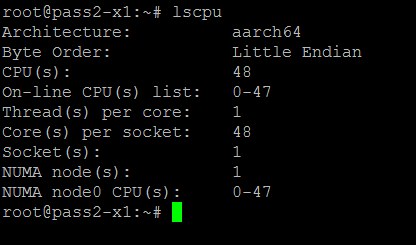Investigating Cavium's ThunderX: The First ARM Server SoC With Ambition
by Johan De Gelas on June 15, 2016 8:00 AM EST- Posted in
- SoCs
- IT Computing
- Enterprise
- Enterprise CPUs
- Microserver
- Cavium
ThunderX SKUs: What is Cavium Offering Today?
Cavium has been promising SKUs with 16 cores or 48 cores, with clockspeed ranges between 1.8 GHz and 2.5 GHz, with a TDP of up to 95W. While I am typing this article, Cavium has not published a full spec list of the different SKUs and the real silicon is different from the paper specs. So we will simply jot down what we do know.
The SKU we tested was the ThunderX-CP CN88xx 2 GHz. It is hard to identify the CPU as the usual Linux CPU identification tools do not tell us anything. Only the BIOS can gave some info:
The SKU we tested (CN8890), has 48 cores at 2 GHz, inside a TDP of 120W and costs around $800. This is the SKU that is being produced at mass scale.
What we know so far:
- SKUs available with Clockspeeds of 1.6 GHz and 1.8 GHz with lower TDPs than 120W (2 GHz)
- Highest clock is 2 GHz
- SKUs with 24, 32, and 48 cores
- Available in all families (Cloud, Storage, Security, Networking) and currently in productions
TDP ranges from 65W (low end, 24 cores at 1.8 GHz ?) to 135W (probably a 48-core SKU at 2 GHz with most features turned on).
But it is safe to say that Cavium missed the target of 48-cores at 2.5 GHz inside a 95W power envelope. That probably was too optimistic, given the fact that the chip is baked with a relatively old 28 nm high-k metal-gate process at GlobalFoundries.












82 Comments
View All Comments
willis936 - Thursday, June 16, 2016 - link
Are you sure that the there are more cores at lower clocks to keep voltage lower? Power consumption is proportional to v^2*f.ddriver - Friday, June 17, 2016 - link
Say what? Go back, read my previous post again, and if you are going to respond, make sure it is legible.willis936 - Friday, June 17, 2016 - link
Alright well if you don't understand why many slower cores are more power efficient even if there was a 0 cycle penalty on context switching then you aren't worth having this discussion with.blaktron - Wednesday, June 15, 2016 - link
48 cores of server processing on 16mb of l2 and 4 channels of RAM? What is this thing designed for. Will be like running single channel celerons as server processors, so decent hypervisor hosts are out, and so is any database work more complex than dynamic web pages.Haravikk - Wednesday, June 15, 2016 - link
Facebook is specifically mentioned as being interested in this, so dynamic web-pages is definitely a valid use-case here. HHVM for example is pretty light on memory usage (so is PHP7 now), especially in high demand cases where you're really only running a single set of scripts, probably cached in a compiled form, plus both scale really well across as many cores as you can throw at them.Things like nginx and MariaDB will be the same, so they're absolutely intended use-cases for this kind of chip, and I think it should be very good at it.
blaktron - Wednesday, June 15, 2016 - link
With no L3 and slow RAM access I'm not sure where you think the scrips will cache. Assuming you ran them on bare metal (horrifying waste of compute) there would be enough, but if you had docker instances or quick spin vms doing your work (as 99% of web servers are) then each instance will only get the tiniest slice of cache to work with. It would be like running your servers, as I said, on a bank of celerons. Except celerons have L3 and don't carry 12 cores per memory channel.spaceship9876 - Wednesday, June 15, 2016 - link
Hopefully someone will release a server chip using 64 cortex A73 cpu cores, i'm pretty sure the cortex a73 will be more power efficient than xeon d. Xeon d beats cortex a57 in power efficiency but i'm pretty sure than cortex a72 will be similar and cortex a73 will beat it.Flunk - Wednesday, June 15, 2016 - link
ARM with ambition?I've heard that before, nothing came of it.
CajunArson - Wednesday, June 15, 2016 - link
Interesting article. This does appear to be the first semi-credible part from an ARM server vendor.Having said that, the energy efficiency table at the end should put to rest any misconceived notions that ARM is somehow magically energy efficient while X86 isn't.
Considering that Xeon E5-2690 v3 is a 4.5 year old Sandy Bridge part made on a 32 nm process and it still has better performance-per-watt than the best ARM server parts available in 2016, it's pretty obvious that Intel has done an excellent job with power efficiency.
kgardas - Wednesday, June 15, 2016 - link
2 CajunArson: (1) you can't compare energy efficiency of CPUs made on different nodes. 28nm versus 14nm? This is apple to oranges. (2) Xeon E5-2690 *v3* is Haswell and not Sandy Bridge and it's not 4.5 years definitely.